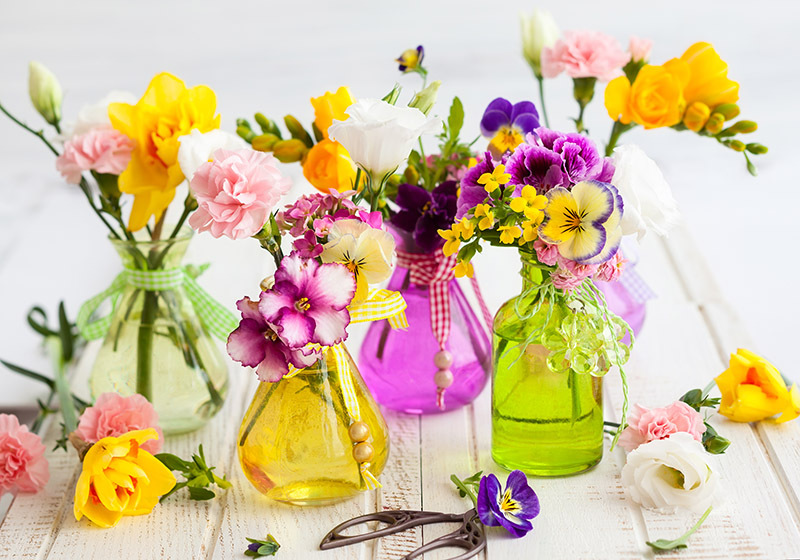Mastering the Art of Preserving Your Cut Flowers
Posted on 03/09/2025
Mastering the Art of Preserving Your Cut Flowers
There is little that compares with the freshness and beauty a bouquet of cut flowers brings to your home. Whether picked from your garden, given by a loved one, or purchased from a local florist, their vibrant colors and delicate scents can transform any space. However, cut flowers are ephemeral by nature--and often, it seems their beauty begins to wane all too soon. If you've ever wondered how to make your fresh blooms last longer, this comprehensive guide on preserving your cut flowers will equip you with essential tips, scientific insights, and creative solutions to help you master the art of flower preservation.

Why Do Cut Flowers Fade?
Understanding why flowers wilt is the first step in effective flower preservation. Once separated from their root system, cut flowers can no longer absorb essential nutrients, water, and sugars from the soil. They rely solely on their stems to take up water and whatever nutrients are in their vase. Several key factors accelerate the decline of cut flowers:
- Transpiration: Loss of water through leaves and petals.
- Bacterial Growth: Bacteria in water block the stems, hindering water absorption.
- Lack of Nutrients: No root system means no natural nutrient uptake.
- Ethylene Gas: A natural plant hormone, which when released, speeds up aging and wilting.
By addressing these factors, you can extend the vase life of your cut flowers and enjoy their presence for much longer.
Essential Tips to Prolong the Life of Your Bouquets
Select the Freshest Flowers
Your preservation efforts start at the source. Follow these selection tips when cutting from the garden or buying from a florist:
- Choose flowers that are just starting to open rather than those in full bloom for a longer vase life.
- Inspect stems and leaves for signs of wilting, mold, or browning.
- Check that petals are firm and not bruised.
- Ask your florist when their latest delivery arrived for the freshest options.
Proper Cutting Techniques
How you cut your flowers greatly influences their longevity. For best results:
- Use sharp, clean scissors or pruning shears to avoid crushing the stem, which can inhibit water uptake.
- Cut stems at a 45-degree angle to increase surface area and prevent them from sitting flat on the vase bottom.
- Recut stems under running water or submerged in water to prevent air bubbles, which can block water absorption.
- Immediately place cut flowers into a container of lukewarm water.
The Right Vase and Water
A clean environment is vital for preserving your cut flowers:
- Wash the vase thoroughly with soap and water to remove any bacteria or residue.
- Fill the vase with lukewarm water--some delicate blooms may require cold water, such as tulips or daffodils.
- Change the water every two days to minimize bacteria growth.
Removing Foliage
Any leaves submerged in water encourage bacterial growth. Before arranging:
- Remove all leaves that will fall below the water line.
- Check for hidden buds or growths that may also rot when submerged.
Use of Flower Food
Commercial packets of flower food usually accompany store-bought bouquets and contain a combination of sucrose (sugar), acidifiers, and antibacterial agents. These help:
- Feed the flowers and prolong vibrancy.
- Lower water pH to inhibit bacteria.
- Keep stems clear for efficient water absorption.
If you run out of commercial flower food, you can make a DIY flower preservative with:
- 1 teaspoon sugar (for nutrition),
- 1 teaspoon bleach or vinegar (to check bacteria), and
- 2 teaspoons lemon juice (for acidity)
- mixed into 1 quart of lukewarm water.
Mind the Temperature and Placement
Where you display your bouquet significantly influences its longevity:
- Keep flowers away from direct sunlight, heating vents, and household appliances which accelerate transpiration and wilting.
- Avoid placing flowers near ripening fruit, as they emit ethylene gas that speeds up flower aging.
- Cooler environments generally extend the life of cut flowers.
Regular Maintenance
To maximize the life of your cut bouquets:
- Change the vase water every two days, and clean the vase in between for optimal hygiene.
- Remove drooping or dead flowers, which can release ethylene gas and shorten the life of the bouquet.
- Re-cut the stems every few days to refresh water uptake surfaces.
- Top up water as needed; blooms can be surprisingly thirsty!
Advanced Flower Preservation Methods
If you want to preserve individual flowers, keepsakes, or create dried arrangements, consider these methods:
Drying Cut Flowers
- Air Drying: Gather flowers into small bunches and hang them upside down in a cool, dry, and dark place for several weeks.
- Pressing: Place flowers between absorbent paper inside a heavy book. Leave for 2-3 weeks.
- Silica Gel: Bury blossoms in silica gel crystals for more delicate flowers (like roses) to help them retain color and shape. This typically takes a week to ten days.
Using Glycerin
Glycerin replaces water in the flower, keeping it soft and supple. Here's how:
- Mix one part glycerin with two parts water.
- Submerge stems in the solution--or soak just the leaves and petals--for 2-3 weeks.
- This works best on broadleaf plants and foliage.
Wax Dipping Flowers
For short-term preservation (for events or decor):
- Melt paraffin wax and allow it to cool until just warm (not hot).
- Dip the flower heads quickly and remove, allowing the wax to set. This temporarily preserves color and structure.
Freeze Drying
Commercial florists may offer freeze drying, which removes moisture without damaging the structure. This professional technique can preserve flowers almost indefinitely with lifelike appearance. It's often used for bridal bouquets or significant sentimental flowers.
Common Mistakes to Avoid When Preserving Cut Flowers
- Neglecting water changes: Letting flowers sit in stagnant water encourages bacteria and accelerates decay.
- Forgetting to recut stems: Flowers regularly need fresh cuts for optimal water uptake.
- Leaving excess foliage underwater: Extra leaves introduce bacteria and clog stems.
- Placing in direct sunlight or warm spots: This drastically shortens vase life.
- Mixing incompatible flowers: Some flowers, like daffodils, secrete sap that is toxic to others when placed in the same water.
Expert Tips for Long-Lasting Bouquets
For those who wish to become true masters in the art of preserving cut flowers, try some of these professional tricks:
- Condition blooms overnight: Leave your freshly cut flowers in cool water in a dark room before arranging.
- Keep arrangements loose: Crowded stems restrict water flow. Minimalist designs often outlast dense bouquets.
- Avoid "flower killers": Some species, like lilies, have high ethylene production or compounds that shorten the life of neighboring blooms.
- Use a hydration spray: Florist hydration sprays can extend the life of delicate blooms like orchids and hydrangeas.
- Experiment with preservation methods: Combine air drying and pressing for unique art or decorations.
Popular Flowers and Their Lifespans
Each type of flower has a unique vase-life. Some common blooms and their average longevity:
- Roses: 6-12 days
- Tulips: 5-7 days
- Lilies: 8-14 days
- Alstroemeria: 14 days
- Sunflowers: 6-12 days
- Irises: 2-5 days
- Carnations: up to 21 days
- Chrysanthemums: up to 28 days
Remember that following proper care procedures can often extend these averages.
Eco-Friendly and Natural Flower Preservation
Interested in sustainable methods of preserving your cut flowers? Try these natural tips:
- Vinegar & Sugar Mixture: As detailed earlier, this feeds and disinfects naturally.
- Aspirin: Crush and dissolve a tablet in water to lower pH and help water uptake.
- Penny in the Vase: The copper has natural antibacterial properties for keeping water clear.
- Keep arrangements simple: Using fewer stems reduces waste and enhances each bloom's effect.

Creative Projects with Preserved Flowers
Once you have mastered the art of cut flower preservation, you can use dried or pressed flowers to create:
- Framed pressed art
- Flower-infused candles or soaps
- Decorative wreaths and potpourri
- Resin jewelry with preserved blooms
- Handmade bookmarks featuring pressed petals
These projects offer a chance to extend the joy your flowers provide, while keeping memories alive in a beautiful, tangible form.
Conclusion: Enjoy Your Bouquets Longer
By following the tips in this comprehensive guide, you can master the art of keeping your bouquets fresh and vibrant. Small steps--like using clean vases, regularly refreshing water, and employing advanced preservation techniques--will help you get the most out of every bloom. Not only will your home stay brighter and more welcoming, but the memories and intentions expressed by your flowers will last that much longer. Make these techniques a part of your routine, and soon, you'll be the go-to source for advice on preserving cut flowers in your family and circle of friends!
Start mastering the art of flower preservation today and bring lasting beauty into your everyday life.
Latest Posts
Spring Flower Planting Guide for [POSTCODE] Residents
Where to See Wildflowers Around [LANDMARK] this Summer
The Symbolic Significance of Peony Flower Hues






